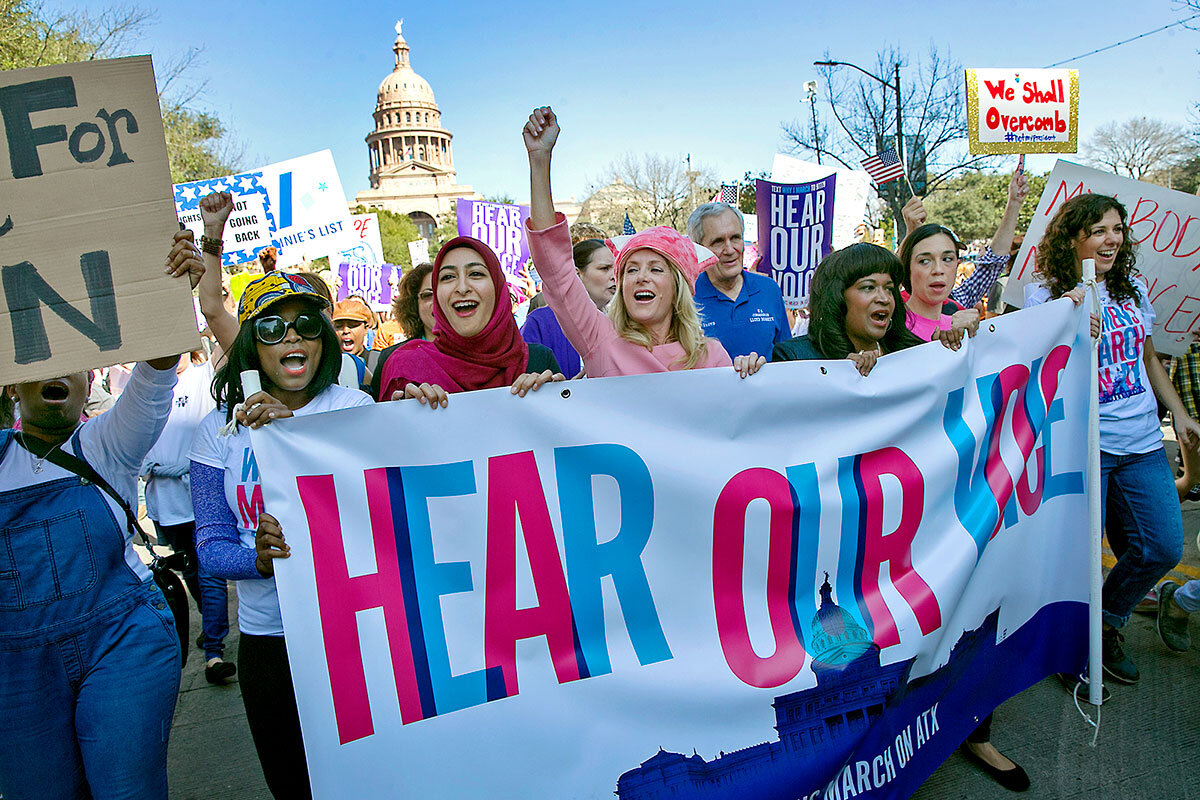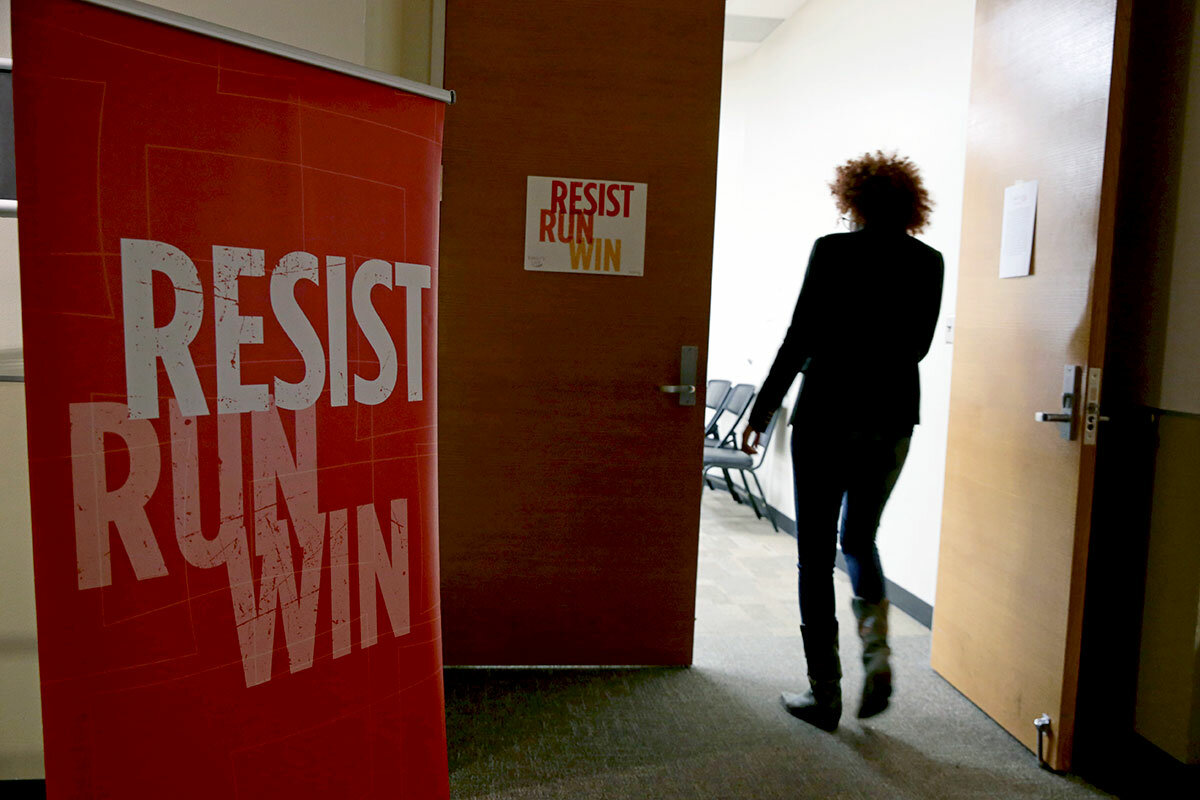A year after the March, women are sprinting forward
Loading...
| Washington
Ginny Dameron didn’t know what to expect from the Women’s March in Austin, Tex., last January. She usually avoids big crowds, and worried about the potential for confrontation. But seeing tens of thousands of people show up at the state capitol, she says, “wowed” her: “It was the sense that we were not alone.”
Odelia Younge also felt conflicted over whether to join the March in San Francisco — at first. Her top causes: reproductive and social justice, especially for the black community. “I decided to show up in a way I wanted to,” she says. She made her mark that day by shouting positive chants with her friends in the crowd — shifting the focus to what they want, not what they’re against.
For Emily Porter, the decision was easier. As a mom to two daughters, she says she felt compelled to be there. Marching on the Mall in Washington, D.C., awoke feelings of empowerment and validation. “It wasn’t just me feeling angry,” she says. “There was a real sense of female community.”
These women’s stories are emblematic of marchers nationwide who took to the streets on Jan. 21, 2017: They came out spontaneously, and for different reasons. And they were ultimately encouraged – and changed – by the experience.
Now, a year later, there’s something else they agree on: the pull toward political engagement has stayed with them. Whether it’s donating to campaigns, hosting forums, or engaging their neighbors, each of them has found a personal way to participate in politics.
“I’ve called my representatives more than in my entire life,” Ms. Porter says.
The same is true of women across the country, who since the marches have rushed to file candidacies at every level of office. That energy has also seeped through to other aspects of American life, amplifying female voices on issues where women have long stayed silent and moving feminism to the center of national discourse.
“The Women's March gave me an opportunity to pull myself out of helplessness and join with others who are advocates for women,” says Miranda Orbach, who went to the march in Washington with her partner and their families. The experience, she says, “grounded and inspired me.”
A hastily organized outpouring
The Women's March ranks comfortably among the largest one-day demonstrations in recorded American history, rivaling the Vietnam War Moratoriums in 1969, the first Earth Day in 1970, and demonstrations opposing the US invasion of Iraq in 2003. Crowd scientists estimated that at least 470,000 people participated on or near the Washington Mall alone. Along with 673 sister marches held in all 50 states and 32 countries, the total number of protesters reached .
It was in many ways a hastily organized outpouring, an organic response to the 2016 election and what many saw as the unprecedented – and unacceptable – divisiveness of the newly elected president, Donald Trump.
“The women’s marches in 2017 reflected a mass sentiment among women across the board against Trump, but for very different reasons,” says Barbara Ransby, a professor at the University of Illinois at Chicago. Some, she notes, were dismayed that Hillary Clinton had lost, after coming so close to becoming America’s first female president. Others were aghast at Mr. Trump’s perceived racism and “the arrogance of wealth and privilege that he exudes.”
“But I think all of those who turned out were outraged by Trump’s flagrant misogyny,” says Professor Ransby. To many, the election of a candidate who had boasted on tape about making unwanted physical advances was simply anathema.
And in hindsight, Jan. 21 turned out to be only the beginning – in more ways than one.
Running for office
Perhaps the clearest and most immediate new channel for the anger, emotion, and energy that fueled the March is politics.
According to the Center for American Women and Politics, are currently considered likely candidates for Congress in 2018 – more than double the number who were on the list in 2015. In races for seats in the House of Representatives, more than 200 female candidates – mostly running as Democrats – are seeking to challenge an incumbent from the opposing party.
In December, Emily’s List, the biggest national organization to support women running for office, told The New York Times that about 1,000 women had reached out to them for help filing a candidacy or otherwise participating in politics in the months leading up to the 2016 election. The number swelled to 22,000 after the election.
California native Jessica Morse counts herself among the politically inspired. A trained national security strategist, Ms. Morse had long nursed a secret desire to run for office.
“The Women’s March gave me the courage to run,” she says.
Today she’s one of three millennial women to compete in the Democratic primary for the Golden State’s Fourth Congressional District. (The winner will challenge five-term incumbent Rep. Tom McClintock (R).)
Those who didn’t feel the pull to serve found other ways of repurposing their newfound political energies. According to by the Center for Responsive Politics, there has been a surge in the number of women donating to Democratic campaigns in this election cycle.
Kitty Thuermer, a Washington-based freelance writer and editor, wound up participating in weekly demonstrations. As one of her friends put it: “Never mind the sorry salad at the desk – every lunch hour was spent at a protest.”
#METOO
The March also opened a tumultuous year in which myriad cases of sexual harassment and abuse came to light. The exposure in October of Hollywood movie mogul Harvey Weinstein as an alleged habitual assaulter became a rallying point for the revival of the #MeToo movement. Suddenly women – from stars to senators and everyone in between – were speaking up about their experiences, many for the first time.
Some have warned of , but the momentum for the most part continues unabated.
The New York Times maintains of the men who have been fired or resigned from high-profile positions because of their sexual misconduct, while Time magazine named “The Silence Breakers” its 2017 Person of the Year. Female representatives in statehouses and Congress are pushing for policy changes that would shift the balance of power between men accused of harassment and the women who accuse them. And early this month, more than 300 women in entertainment, law, and public relations launched the Time’s Up campaign and legal defense fund to support survivors of sexual harassment and retaliation in the workplace.
It’s the start of a transformation that “will take generations to become the norm,” says Ms. Dameron, the marcher from Austin, who remembers a time when the sole instruction for girls was to act like a lady. “[But] I am grateful for the change.”
Smaller-scale efforts
Not everyone who participated in last year’s March took part in sweeping movements attached to headline-grabbing figures. For many, engagement took the form of smaller-scale efforts to drive change in their communities.
Ms. Orbach, who teaches third grade in New York City, has devoted herself to prison and parole advocacy, helping prisoners in state institutions put together parole packets and prepare for their boards. “I knew that the Trump administration would affect the prison industrial complex in a negative way,” Orbach says. “It felt even more important to spend time listening to people’s stories and helping them advocate for themselves.”
In San Francisco, Ms. Younge has used her blog as a space for people who want someone to talk to about sensitive topics. She also co-hosts events that celebrate feminism and the female body. “It gets me excited to use the arts to create internal resistance,” she says. “Hopefully, it will lead to external resistance as well.”
Across the bay in Oakland, Cristine Blanco has made having difficult conversations a personal priority. She’s been active in the Black Lives Matter marches and with organizations that uplift marginalized groups.
“I think it’s great that people are more open to discuss their concerns about what is happening in America,” she says.





